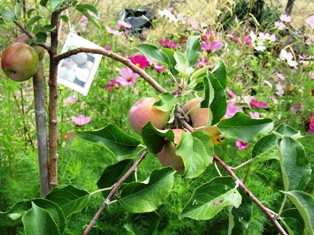Grafting Expands Fruiting Options
Last year during bare-root season, I purchased a multi-variety tree offering several types of apples, including the Fuji pictured above as well as Einsheimer. Sometimes spelled as Ein Schemer, this apple variety comes from Israel and has low-chill requirements, unlike some apples that need many hours of chilling. It’s a good choice for southwestern U.S. and Northern California gardens.
Anna and Beverly Hills are the other two varieties grafted onto my multi-apple tree. Such trees are ideal if you have limited space and cannot plant more than one tree. Apple trees also look lovely espaliered against a wall.
Apples live longer than many of the deciduous fruit trees. They have short fruit spurs that can produce apples for up to 20 years. The only pruning required is to remove dead, weak, damaged or crossed branches and twigs.
A true dwarf apple won’t exceed 5 to 6 feet in width and height; a semi-dwarf, however, can easily reach 10 to 15 feet. Apples like deep soil but many will tolerate less-than-ideal soil; even soil with poor drainage or clumpy clay soil. Some apples are self-fruitful and others need a pollinizer (which might not be a problem if you have other pollinizing apple trees in your neighbor’s yards.)
I took a class years ago through University of California (Santa Cruz extension) to learn grafting. The process is not difficult to master. And the only tool you truly need is a sharp knife to cut a piece of stem (called a scion). The scion must have a couple of growth buds on it.
Stock is the plant you will graft the scion onto. For example, you might want to graft an Anna variety apple scion onto a Fuji apple tree (stock). You will cut the scion from the Anna and insert that scion into into the Fuji. Select a scion roughly the same diameter as the stock branch (you will graft the scion onto). The union (when the graft succeeds) is a new branch that carries the Anna apple.
The tricky part of grafting is aligning the cambium layer of the scion with the cambium layer of the stock. So how do you find the cambium. Simple. The cambium is the tissue-thin layer between the bark and the inner wood of the tree.
Cut the end of the scion into a wedge (like an ax edge or a two-sided tip of an arrow) and also make a cut into the branch of the stock. Then slide the tip of your scion into the stock, making sure that cambium aligns with cambium. I like to then bandage the grafting area to hold the scion in place until the graft has taken.
There are other ways to graft, but this one has worked best for me. For western gardeners, Sunset’s Western Garden Book has great illustrations and directions for grafting. Also the following website for the University of Minnesota provides easy-to-follow instructions. See, http://www.extension.umn.edu/distribution/horticulture/dg0532.html.
You increase your chances for success if you graft like varieties to each other and also if you do the grafting during the dormant season before buds start showing up and swelling. Grafting expands your options for multiple varieties of fruits on the trees in your garden. Just remember to graft varieties of scion and stock that are botanically similar.
Tags: Anna, Beverly Hills, cambium, chilling requirement, Einsheimer, Fuji, graft, scion, stock
 Facebook
Facebook Goodreads
Goodreads LinkedIn
LinkedIn Meera Lester
Meera Lester Twitter
Twitter




